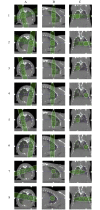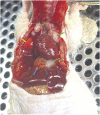Validation of an orthotopic non-small cell lung cancer mouse model, with left or right tumor growths, to use in conformal radiotherapy studies
- PMID: 37053154
- PMCID: PMC10101527
- DOI: 10.1371/journal.pone.0284282
Validation of an orthotopic non-small cell lung cancer mouse model, with left or right tumor growths, to use in conformal radiotherapy studies
Abstract
Orthotopic non-small cell lung cancer (NSCLC) mice models are important for establishing translatability of in vitro results. However, most orthotopic lung models do not produce localized tumors treatable by conformal radiotherapy (RT). Here we report on the performance of an orthotopic mice model featuring conformal RT treatable tumors following either left or right lung tumor cell implantation. Athymic Nude mice were surgically implanted with H1299 NSCLC cell line in either the left or right lung. Tumor development was tracked bi-weekly using computed tomography (CT) imaging. When lesions reached an appropriate size for treatment, animals were separated into non-treatment (control group) and RT treated groups. Both RT treated left and right lung tumors which were given a single dose of 20 Gy of 225 kV X-rays. Left lung tumors were treated with a two-field parallel opposed plan while right lung tumors were treated with a more conformal four-field plan to assess tumor control. Mice were monitored for 30 days after RT or after tumor reached treatment size for non-treatment animals. Treatment images from the left and right lung tumor were also used to assess the dose distribution for four distinct treatment plans: 1) Two sets of perpendicularly staggered parallel opposed fields, 2) two fields positioned in the anterior-posterior and posterior-anterior configuration, 3) an 180° arc field from 0° to 180° and 4) two parallel opposed fields which cross through the contralateral lung. Tumor volumes and changes throughout the follow-up period were tracked by three different types of quantitative tumor size approximation and tumor volumes derived from contours. Ultimately, our model generated delineable and conformal RT treatable tumor following both left and right lung implantation. Similarly consistent tumor development was noted between left and right models. We were also able to demonstrate that a single 20 Gy dose of 225 kV X-rays applied to either the right or left lung tumor models had similar levels of tumor control resulting in similar adverse outcomes and survival. And finally, three-dimensional tumor approximation featuring volume computed from the measured length across three perpendicular axes gave the best approximation of tumor volume, most closely resembled tumor volumes obtained with contours.
Copyright: © 2023 Wang et al. This is an open access article distributed under the terms of the Creative Commons Attribution License, which permits unrestricted use, distribution, and reproduction in any medium, provided the original author and source are credited.
Conflict of interest statement
The authors have declared that no competing interests exist.
Figures










Similar articles
-
Potential for reduced toxicity and dose escalation in the treatment of inoperable non-small-cell lung cancer: a comparison of intensity-modulated radiation therapy (IMRT), 3D conformal radiation, and elective nodal irradiation.Int J Radiat Oncol Biol Phys. 2003 Nov 1;57(3):875-90. doi: 10.1016/s0360-3016(03)00743-0. Int J Radiat Oncol Biol Phys. 2003. PMID: 14529795
-
[Relationship of dose-volume histogram parameters and computed tomography grading of radiation-induced lung injury in patients with non-small cell lung cancer treated by three-dimensional conformal radiotherapy].Zhonghua Zhong Liu Za Zhi. 2008 Sep;30(9):676-81. Zhonghua Zhong Liu Za Zhi. 2008. PMID: 19173909 Chinese.
-
Comparison of anisotropic aperture based intensity modulated radiotherapy with 3D-conformal radiotherapy for the treatment of large lung tumors.Radiother Oncol. 2012 Feb;102(2):268-73. doi: 10.1016/j.radonc.2011.10.006. Epub 2011 Nov 17. Radiother Oncol. 2012. PMID: 22100654
-
Clinical implications of defining the gross tumor volume with combination of CT and 18FDG-positron emission tomography in non-small-cell lung cancer.Int J Radiat Oncol Biol Phys. 2007 Mar 1;67(3):709-19. doi: 10.1016/j.ijrobp.2006.09.046. Epub 2006 Dec 29. Int J Radiat Oncol Biol Phys. 2007. PMID: 17197120 Review.
-
Defining target volumes for non-small cell lung carcinoma.Semin Radiat Oncol. 2004 Oct;14(4):308-14. doi: 10.1016/j.semradonc.2004.07.004. Semin Radiat Oncol. 2004. PMID: 15558505 Review.
Cited by
-
Radiation-induced amphiregulin drives tumour metastasis.Nature. 2025 Jul;643(8072):810-819. doi: 10.1038/s41586-025-08994-0. Epub 2025 May 14. Nature. 2025. PMID: 40369065
References
Publication types
MeSH terms
LinkOut - more resources
Full Text Sources
Medical

